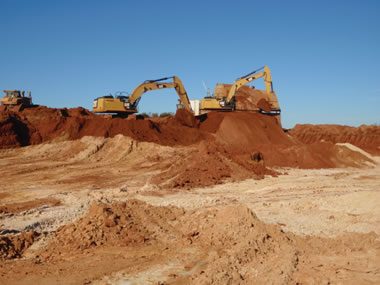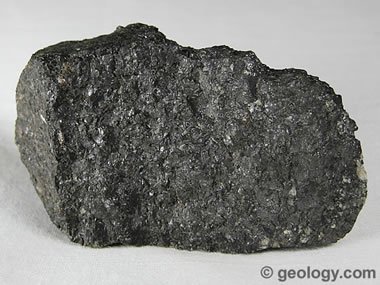Ilmenite
A black iron titanium oxide mineral. The primary ore of titanium, source of titanium dioxide.
Article by: Hobart M. King, PhD

Ilmenite: A specimen of massive ilmenite from Saint-Urbain, Quebec, Canada. Massive ilmenite can be formed as a vein-filling material or during magmatic segregation. This specimen is approximately 4 inches (10 centimeters) across.
What is Ilmenite?
Ilmenite is a common accessory mineral in igneous rocks, sediments, and sedimentary rocks in many parts of the world. Apollo astronauts found abundant ilmenite in lunar rocks and the lunar regolith. Ilmenite is a black iron-titanium oxide with a chemical composition of FeTiO3.
Ilmenite is the primary ore of titanium, a metal needed to make a variety of high-performance alloys. Most of the ilmenite mined worldwide is used to manufacture titanium dioxide, TiO2, an important pigment, whiting, and polishing abrasive.

Heavy Mineral Sand: Shallow digging at Folly Beach, South Carolina, exposes thin layers of heavy-mineral sands. Most of the ilmenite mined today is from sands with a heavy mineral concentration. Photograph by Carleton Bern, United States Geological Survey.

Mining Heavy Minerals: Excavators remove heavy mineral sands at the Concord Mine in south-central Virginia. Weakly consolidated sands containing about 4% heavy minerals are excavated and processed to remove ilmenite, leucoxene, rutile, and zircon. The sands were weathered and eroded from an anorthocite exposure a short distance away. Photo by the United States Geological Survey.
Geologic Occurrence
Most ilmenite forms during the slow cooling of magma chambers and is concentrated through the process of magmatic segregation. A large underground magma chamber can take centuries to cool. As it cools, crystals of ilmenite will begin forming at a specific temperature. These crystals are heavier than the surrounding melt and sink to the bottom of the magma chamber.
This causes ilmenite and similar-temperature minerals, such as magnetite, to accumulate in a layer at the bottom of the magma chamber. These ilmenite-bearing rocks are often gabbro, norite, or anorthosite. Ilmenite also crystallizes in veins and cavities and sometimes occurs as well-formed crystals in pegmatites.
Ilmenite has a high resistance to weathering. When rocks containing ilmenite weather, grains of ilmenite disperse with the sediment. The high specific gravity of these grains causes them to segregate during stream transport and accumulate as "heavy mineral sands." These sands are black in color and easily recognized by geologists. "Black sand prospecting" has long been a method of finding heavy mineral placer deposits. Most commercially produced ilmenite is recovered by excavating or dredging these sands, which are then processed to remove the heavy mineral grains such as ilmenite, leucoxene, rutile, and zircon.

Ilmenite: A specimen of massive ilmenite from Normanville, South Australia. Specimen is approximately 3 inches (7.6 centimeters) across.
Chemical Composition of Ilmenite
Ilmenite's ideal chemical composition is FeTiO3. However, it often departs from that composition by containing variable amounts of magnesium or manganese. These elements substitute for iron in complete solid solution. A solid solution series exists between ilmenite (FeTiO3) and geikielite (MgTiO3). In this series, variable amounts of magnesium substitutes for iron in the mineral's crystal structure. A second solid solution series exists between ilmenite and pyrophanite (MnTiO3), with manganese substituting for iron. At high temperatures, a third solid solution series exists between ilmenite and hematite (Fe2O3).

Ilmenite: A specimen of massive ilmenite from Kragero, Norway. Specimen is approximately 4 inches (10 centimeters) across.

Black Sand Ilmenite: Ilmenite sand from Melbourne, Florida. Specimens are sand-size grains.
Physical Properties of Ilmenite
Ilmenite is a black mineral with a submetallic to metallic luster. With just a glance it can easily be confused with hematite and magnetite. The differentiation is easy. Hematite has a red streak, while ilmenite has a black streak. Magnetite is strongly magnetic, while ilmenite is not magnetic. Occasionally ilmenite is weakly magnetic, possibly from small amounts of included magnetite.
Physical Properties of Ilmenite |
|
| Chemical Classification | Oxide |
| Color | Black |
| Streak | Black |
| Luster | Metallic, submetallic |
| Diaphaneity | Opaque |
| Cleavage | None |
| Mohs Hardness | 5.5 to 6 |
| Specific Gravity | 4.7 to 4.8 |
| Diagnostic Properties | Streak; sometimes weakly magnetic. |
| Chemical Composition | Iron titanium oxide - FeTiO3. Sometimes has significant amounts of magnesium and manganese in solid solution with the iron to yield a composition of (Fe,Mg,Mn)TiO3 |
| Crystal System | Trigonal |
| Uses | The primary ore of titanium. A minor source of iron. Used to make titanium dioxide. |
Ilmenite is usually more durable than the other minerals in the igneous rocks in which it is abundant. For that reason, the weathering debris produced during the weathering of these rocks is especially rich in ilmenite. Its relatively high specific gravity causes it to become concentrated in placer deposits like gold, gems, and other heavy minerals.

Pigments and Polishing Compounds: Titanium dioxide powder is carefully processed to remove impurities and classified by particle size. It is then sold for use as whiting, pigments, and polishing compounds. The image is a rock tumbler barrel just opened with a thick white froth of metal oxide polish.

Lunar Ilmenite Basalt: Apollo astronauts found ilmenite-rich basalts at multiple locations on the Moon. The reference block at lower right is one cubic centimeter. Image by NASA.
Uses of Ilmenite
Ilmenite is the primary ore of titanium metal. Small amounts of titanium combined with certain metals will produce durable, high-strength, lightweight alloys. These alloys are used to manufacture a wide variety high-performance parts and tools. Examples include: aircraft parts, artificial joints for humans, and sporting equipment such as bicycle frames. About 5% of the ilmenite mined is used to produce titanium metal. Some ilmenite is also used to produce synthetic rutile, a form of titanium dioxide used to produce white, highly reflective pigments.
Most of the remaining ilmenite is used to make titanium dioxide, an inert, white, highly reflective material. The most important use of titanium dioxide is as a whiting. Whitings are white, highly reflective materials that are ground to a powder and used as pigments. These pigments produce a white color and brightness in paint, paper, adhesives, plastics, toothpaste, and even food.
Titanium dioxide is also used to make powders with a tightly controlled particle size range. These powders are used as inexpensive polishing abrasives in a variety of lapidary work that includes rock tumbling, lapping, cabbing, sphere making, and faceting. Titanium oxide abrasives are used in many other industries.

Lunar Ilmenite Regolith: Apollo astronauts found deposits of lunar regolith composed mostly of silt- to sand-size ilmenite (black) and mafic volcanic glass (orange). Image by NASA.

The best way to learn about minerals is to study with a collection of small specimens that you can handle, examine, and observe their properties. Inexpensive mineral collections are available in the Geology.com Store. Image copyright iStockphoto / Anna Usova.
Ilmenite on the Moon
Apollo astronauts found ilmenite-rich basalts at multiple locations on the Moon. Most of these basalts were extremely old, forming at least 3 billion years ago. These rocks often contained over 10% titanium dioxide (TiO2). Minerals present in these rocks were mostly feldspars and pyroxenes, with ilmenite next in abundance.
Some samples of lunar regolith contained significant amounts of ilmenite. It occurred in particles ranging from fine silt to coarse sand. The ilmenite was thought to have been liberated from lunar basalts during impact events.
Samples of lunar regolith collected at Shorty Crater contained a mix of volcanic glass spheres and ilmenite grains. The deposit was stratified with a bottom layer composed mostly of ilmenite and other black opaque materials. This graded upwards to an upper layer, known as "orange soil," that was composed mostly of spherical-shaped beads of orange volcanic glass with minor amounts of ilmenite. The grains were mostly less than 1/2 millimeter in size. This regolith was thought to have been produced by fountaining volcanic eruptions during the early lunar history.
| More Minerals |
 |
Herkimer Diamonds |
 |
The Acid Test |
 |
Tumbled Stones |
 |
Zircon |
 |
Fool*s Gold |
 |
Kyanite |
 |
Rock Tumblers |
 |
Rhodochrosite |

Find Other Topics on Geology.com:

|

| ||

|

| ||

|

| ||

|

|
